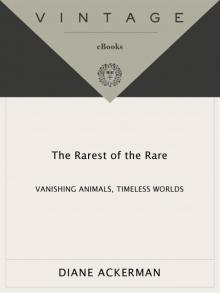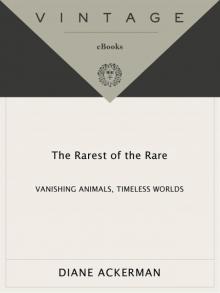- Home
- Diane Ackerman
The Rarest of the Rare Page 4
The Rarest of the Rare Read online
Page 4
Mobbing, they call it, as if it were nothing more painful than a political rally or a peaceful gathering of kangaroos. Torture and brutality lurk in that euphemism. Because nature neither gives nor expects mercy, one often finds naturalists inured to violence. Our prime directive is not to intrude as nature goes about its ways. A skua has chicks that must eat, just as a penguin does. Still, it’s painful to watch a skua stab a baby penguin to death and rip out its entrails. When I saw that happen in the Antarctic, I felt as if someone were yanking a steel cable that led directly into my heart. Nature is indeed “red in tooth and claw,” as Tennyson said. Of all the qualities that define us, pity, mercy, and compassion are among the most remarkable. One sometimes hears of household pets being sympathetic, or of dolphins aiding drowning humans, but who can tell the motives of animals? As dolphin specialist Karen Pryor once quipped, “Maybe we never hear from the people dolphins carried out to sea.”
One thing I find especially disturbing is that throughout the animal kingdom, although different species vary in their mating rituals, violence to females is the rule. Even among our closest relatives, the chimpanzees, females who refuse sex to males may be killed. In Patagonia, I saw a massive bull elephant seal assaulting one female after another along the beach. In each case, he ripped open the neck of the female, who bled profusely and bellowed in agony; then he crushed her flippers under his weight as he mated with her, and rolled over her pup, killing it. Evolution can be a cruel and merciless parent, in whom extreme behavior can be triggered by the slightest shift in circumstance. Of all the hazards facing monk seals, the toughest to outwit may be their own rash instincts. Female monk seals would not normally be slaughtered during mating; it’s only because so few are left that the species is being sabotaged by frenzied males. A bonus of female pups would solve the problem. But how could that be achieved? Unlike crocodilians, which can choose the sex of their offspring by where they place the eggs in the nest, seals are slaves to chance. Therefore every female monk seal must be protected. Mobbing is so acute a problem that the Monk Seal Project has begun a treatment program to calm the males. The idea is to lower the testosterone level of the most violent offenders. At Sea Life Park in Honolulu, the curator of marine mammals, Marlee Breese, oversees such an experiment with four adult male monk seals, whom she refers to as the CRAMS (Convicted Rapists and Murderers). If the experiment works, it will curb the deadliest males long enough to bring the ratio of males and females back into equilibrium.
Moving to a polite distance, we watch the newly tagged pup roll over in the sand and return to basking as if nothing special had happened. Gil is pleased to find a female pup that’s fat and healthy and full of spunk.
“How do you know which males to treat?” I ask, as we put the tagging gear back into the white bucket.
“It’s important that we don’t treat the dominant breeding males,” he explains. “The dominant males probably give the females some protection from the groups of attacking younger males. The program seems to be working on the test animals. The next step is to go into the field with the drug and treat about sixty males at Laysan, one of the two islands where mobbing is the worst.”
Half-dollar-sized quiverings in the sand take shape as small funnels, and I know baby green turtles are squirming somewhere below, wading slowly through their deep nest. Tonight they will struggle free and begin a long pilgrimage to the water. Three researchers at Tern Island regularly check their doings. When they find a nest of trapped hatchlings here on East Island, they excavate it carefully and take the turtles back to Tern to be set free by moonlight. Threading my way around the turtle craters and bird nests, I step over a small fishing float and plunge through a trapdoor straight down into a shearwater’s nest, then tumble onto my knees.
“Who pulled the ripcord?” I ask. After climbing out, I kneel beside the cave-in, scoop the sand away, and look carefully inside in case a chick might be trapped; fortunately, the nest is empty. Bill nods thoughtfully. The island is a hidden maze of birds’ and turtles’ dwellings, and he will need to protect his cameras if he falls. From a distance, East Island had appeared flat as a sand dollar, but its gentle dunes rise high enough to hide sleeping monk seals, and as we continue our walk, we chance upon many more of them lying peacefully in the surf, always facing out to sea. Are they being watchful, I wonder? Are they oriented toward incoming sharks? Or does a seal relish the feel of the waves lapping at the whiskers, skirling around the muzzle, sudsing the nose? Unlike other seals, which tend to crowd, monk seals don’t form large groups. They’re more ascetic (hence their name) and haul out alone. Lying parallel on the beach at regular intervals, they seem separated by an invisible force—a kind of reverse magnetism. Today, the seals occupy all the beaches, but in spring the mothers nurse mainly on the south side of the island, where shallow waters ripple. Ten- to twelve-foot tiger sharks patrol the waist-deep water of the north side, on the lookout for wayward pups or birds. Spring is the albatrosses’ fledging season, and sharks wait for naïve chicks to land on the water and then snatch them under.
At the end of East Island, we approach the spindly Loran C tower, which stands like a lightning rod. On it, a blue-and-white sign reads: “National Wildlife Refuge.” How can a patch of sand as small as this be a refuge? What is it exactly that the seals, turtles, and birds are seeking refuge from? Predators? The changing blueprint of evolution? Us? Have we become such bullies that we’ve driven other creatures to awkward hideaways? Some of Earth’s rarest animals survive only in the small cloister of a hidden atoll, or the dense asylum of a highland forest, or the rocky fortress of an active volcano. In a sonnet addressed to a loved one, Sir Thomas Wyatt laments: “They flee from me, that sometime did me seek.” Do they now flee from us, animals that once shared our beaches and savannas? Or, equally worrisome thought, have we already wiped out most animals within reach, sparing only those that dwell in remote landscapes? The islands of French Frigate Shoals do not look like a refuge. In fact, they themselves seem to need dredging and bolstering. Perhaps we are confused about what a refuge really is—not a place as much as a willingness. A battered child might find refuge with a grandparent. A resistance fighter might find refuge in a hayloft. All the refuge sign really identifies is a mood, a stubborn protectiveness. The extinction of these animals will stop here, it demands, on this small raft of sand. Not because the island offers much shelter, but because the slide to extinction that these animals are traveling must stop somewhere. Why not here?
Below the refuge sign sits a white wooden box with a latch door. I open it. Someone has tacked up a poem—“Walk Softly”—to celebrate the sacredness of the place. Inside the door, photographs show the original Coast Guard base. Small beetles scuttle over the photographs and for a moment the base seems to be bustling with life. The white skeleton of a spider blows across the hinge. Other evidence of the base still litters the island: teal-blue copper carcasses of machinery half buried in sand, sonabuoy containers, a heap of cement debris. Though such leavings probably don’t bother the seals, they are an eyesore. Whenever Gil visits East Island, he carries one brick away with him and drops it at sea. It will take ages to dispose of the rubble at this pace, but nature knows no rush; why should he? In time his plan will work. He also collects washed-up fishing-line remnants because playful monk seal pups often get tangled in them.
A masked booby flies over and the ocean reflects pale blue across its chest as it glides low and lands near two mother seals with their three-week-old pups. Waiting in the shallows, another mother calls to her snoozy pup, and the baby baahs back in a slightly higher register, then waddles into the water and darts to her, otter-fast. Monk seals make quirky sounds—from stuttering grunts to high foghorn blasts—with mothers and pups sharing the greatest range of calls. Some seals have tiny patches of blond fur, which glisten in the sunlight. No one is sure how such curious markings evolved, but they help to identify individuals. Could there once have been blond or even spotted monk seals?
&nb
sp; “Oh, look at that,” Gil says, wincing. I follow his gaze to a pup that has no rear flippers left. A shark has chewed them clean away, leaving only a thick red stump.
“God, I hope it’s not a female,” Gil says. “If it is, we’ll have to catch her, put a tourniquet on the tail, carry her to the boat, take her back to Tern, and fly her to Honolulu. Maybe she could be treated there and used for breeding.”
Sea Life Park in Honolulu already has six females in their rehabilitation program. Ten years ago, researchers discovered that monk seals practice “fostering.” If two mothers are nursing pups and the pups briefly stray, it’s likely that the mothers will exchange pups. Either they can’t tell whose pup is whose or they don’t care. At first glance, this altruism may seem helpful. If there are few members of a population, isn’t it smart for everyone to look after the young? But unfortunately, mother monk seals can’t continue nursing forever. When a swap takes place, a younger pup may end up with a mother that has been raising an older pup. That mother would already have been nursing for some time and would not have enough milk left to raise the young pup. Weaned too soon, the undersized pup would not be able to feed itself. Those are the animals the Monk Seal Project takes to Honolulu to fatten up. Then they’re released where they’re needed, on a part of the Shoals where the population is low or there are too few females. Twenty-five females have been collected since 1984, and fifteen have been returned to the wild. The other ten died.
“Primarily of heart problems of unknown origins,” Gil explains as he sits down on a large blue fishing float, balancing it underneath him as it tries to roll. “In the beginning we assumed all they needed was fattening up, but some have health problems we can’t deal with. In a wild population, you always find some animals with health abnormalities.” In a large herd, sick animals would not be missed; but in a dwindling herd, they’re obvious and daunting. One problem with endangered animals is that their numbers are so low that it’s hard to decide if an illness is random and to be expected or is caused by some new artificial pressure.
When Dale Rice and Karl Kenyon counted the seals in the 1950s, they found approximately 1,100 on the beaches of French Frigate Shoals, and it’s believed that the islands’ total population was two or three times that, since the seals don’t all use the beaches at the same time. A count in 1977 put the total population at about 700 animals—down by more than 50 percent. In 1987, 474 seals were counted on the beaches, suggesting a total population of about 1,200. The birth rate has been continuing to increase over the last few years, but it’s still dangerously low, and for some reason it dropped in 1989. An odd fact that may be relevant is that there is no word for “monk seal” in Polynesian, nor does the monk seal appear in Polynesian myths. In fact, little is known about its history. Perhaps there never were many monk seals in the South Pacific. We know more about their history in the Caribbean, where Columbus encountered tawny-brown monk seals on his second voyage (in 1494) and named them lobos del mar or “sea wolves.” In 1707 a West Indian traveler wrote: “The Bahama Islands are filled with seals. Sometimes fishers will catch a hundred in a night.” And in the Mediterranean as late as the fifteenth century the monk seal was plentiful enough to fuel a commercial fishery and give its name to a Greek city, Phocaea. But how many monk seals did the Hawaiian waters support? Were there great rookeries of them or only small strongholds? Did their extinction begin many millions of years ago because they abandoned the harem-keeping that other seals find so successful? We may never know.
What could be more serene than sitting on coral sand, while the sun mounts the sky, the monk seals bask, and the breeze blows the surf into a gentle lather. For a moment, there’s no sign of all the commotion taking place to save these few seals. At Sea Life Park alone, every day, handlers drain the water from the female monk seals’ pool, catch the six seals in nets, drag them up the steep cement walls, hold them down, and force-feed them whole fish. Orphan pups are too young to feed themselves. We think of hunger as a universal drive and teacher, but the young pups don’t even understand that they must eat, and without help they will starve. At Kure atoll, a string of nearby islands that aren’t part of the refuge, there is an enclosure where pups are fattened up, raised through their first summer, and taught to feed before being turned loose. Part of what makes monk seals so challenging to the people who work with them is that they pose so many different problems. There is the mobbing, the fostering, the human interference, the entanglement in fishing nets, the reluctance of pups to feed, the dwindling populations in some parts of the shoals but not in others. This morning alone, we have tagged pups, been ready to transport a shark-bitten animal, kept a sharp eye out for pups inadvertently orphaned by fostering, seen a victim of mobbing. It’s animal by animal that you save a species. Not long ago, monk seals were considered disposable. The National Marine Fisheries Service insisted that they were a “relict species,” as they put it, unsavable, a waste of time and resources. Outraged and saddened, John Twiss, now executive director of the U.S. Marine Mammal Commission, argued hard for the protection of these endangered animals, pointing out that they live “entirely within our U.S. waters.” When NMFS refused, he pleaded directly with Congress, which gave him a small amount of start-up money for the Monk Seal Project. Only a few years later, this “relict species” has a slender chance. In the annals of extinction, that is a major accomplishment. Twiss considers it an object lesson in what can be done with little money but a lot of determination. It has not been an easy battle. That scarcity equals value is an absolute law of commerce. And, unfortunately, that’s just as true of animals as of gold. Monk seals have been fought over in boardrooms by people of good and bad conscience, good and bad moral character. Many of the players have changed teams or changed animals. But with some funding, volunteers, new strategies, and an energetic proponent in Washington, the monk seals are managing to hold on. “It’s possible that we will be successful,” Twiss once told me. “It’s just possible.”
A mummified seal carcass, lying on the beach, looks too shriveled and battered ever to have been four hundred pounds of yearning and appetite, or even a rib cage and a tree of blood. Soon it will be tugged apart by the waves, snagged on the sand, split into minute pieces. Objects left in the ocean lose their hard edges and are broken up into formlessness. They become more like the ocean itself. In time, all things placed in the sea become the sea. The sea excels at certain tasks, such as sorting stones according to size, but mainly it reduces things to their constituent chemicals, frees them of the burden of form, returns them to the general flux of the universe.
A large male monk lifts its head, cocks an eye at us, snuffles, puts its head back on the damp sand, and closes its eyes. I wonder what they make of us shy humans strolling along the dunes, occasionally plunging through a wedgie hole, taking care not to disturb their slumber.
“We’re finished here,” Gil says. “Let’s have a look over at Whale-Skate.”
Collecting our gear, we return to the orange whaler, and Gil hands round canned walnuts, a bottle of lukewarm water, and small tart apples. Collecting the beach anchor, I carry it to the boat; Bill pulls up the sea anchor and Gil radios the field station that we’re leaving East Island. Next stop is Whale-Skate, the easternmost of the southern islands, about three and a half miles east of Tern. Actually, it’s two islands: plump, curving Whale and tiny semidetached Skate. Together, they stretch only about two thousand feet, and sometimes the ankle-deep channel between them floods or Skate completely submerges.
As we weave among the coral heads and finally inch our way to shore, a pup swims out to greet the orange whaler. So much shimmery orange must intrigue it. Slipping over the bow, I carry the anchor ashore, plant it, and wade back to the boat. Swinging around from the port side, the pup paddles toward me, and I sit down up to my shoulders in the water, to look smaller and less threatening, as it sneaks in close, twitching its nose and having a good look-see. For long seconds, its stares hard, and I talk to it in a high voic
e (I’ve noticed that most animals are more threatened by low voices). Casting a few more glances over its shoulder, it turns to grab one of the empty bottles bobbing beside it, tosses it in the air, nudges it with his nose. This pup doesn’t need to feed itself yet, but it’s never too early to practice. What feeding monk seals usually do is dive down twenty-five to four hundred feet on the reef, find a spiny lobster, and slap it on the surface of the water to break it, then eat just the succulent tail. Their diet also includes eels, squid, octopi, and some reef fishes. Popping its head up in the periscopelike way that seals do, the pup watches us, then has a rollicking good sneeze. Pups are troubled by nose mites, too, but they vocalize in a higher register than adults—when they sneeze they sound like tearing butcher paper. Tiring of the bottle, the pup swims toward me again, this time straight across the anchor line, which it lies on top of, paddle-flailing in a splashy commotion of flippers, until it gets bored at last and swims away.
A mother monk baahs to her black pup, which baahs back. For forty days she will tend her pup without eating. During that time, the pup will gain 175 pounds, but the mother will lose 350 pounds. At last, scrawny and famished, she’ll go out on a feeding binge, then find a mate. Next she’ll spend seven to ten days molting, during which time she’ll fast once more. We find several slender nursing mothers on Whale-Skate, and a few fat new pups to tag. One of them has a large, angry abscess on its back. Taking a razor blade from his kit, Gil sneaks up on the pup, straddles it, and quickly lances the wound so that, cleansed by the salt water, it can drain.
Afternoon begins rouging toward sunset as we pack up and start back. Reflecting the shallow water, green-bottomed clouds float above us. All the horizons are thick with clouds, some minty, some blue-white, wrapping us round and straggling high to where gauzier clouds stretch. It’s like sailing through a planetarium. The planet’s roundness and the great dome of the sky become obvious. Soon Tern Island appears, and we put the whaler away for the night and head into the barracks for showers and dinner.

 A Natural History of Love
A Natural History of Love The Rarest of the Rare: Vanishing Animals, Timeless Worlds
The Rarest of the Rare: Vanishing Animals, Timeless Worlds The Zookeeper's Wife: A War Story
The Zookeeper's Wife: A War Story The Human Age: The World Shaped by Us
The Human Age: The World Shaped by Us A Natural History of the Senses
A Natural History of the Senses One Hundred Names for Love: A Memoir
One Hundred Names for Love: A Memoir The Rarest of the Rare
The Rarest of the Rare